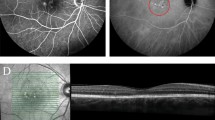Abstract
Purpose. To determine the effects of photodynamic therapy (PDT) on choroidal and retinal structures of human eyes.
Methods. One eye from each of three patients with large malignant melanomas of the uvea destined for enucleation received PDT using verteporfin according to the approved treatment recommendations for patients with age-related macular degeneration. Two laser spots and two light doses (50 J/cm2 and 100 J/cm2) were applied in unaffected chorioretinal areas. The effects of PDT were assessed by fluorescein and indocyanine-green angiography. The eyes were enucleated 1 week later, fixed in buffered paraformaldehyde/glutaraldehyde solution, bisected along the laser spots, and processed for light and electron microscopy.
Results. In agreement with the clinical angiographic findings of hypofluorescence, a rather selective occlusion of the choriocapillary layer was observed in the 50-J/cm2 PDT areas, whereas the 100-J/cm2 PDT areas additionally revealed closure of deeper choroidal vessels and focal alterations of the retinal pigment epithelium. The overlying neurosensory retina, including photoreceptors and retinal capillaries, was well preserved in all PDT areas. Electron microscopy showed that alterations of the choriocapillary endothelium comprised swelling, shrinkage and fragmentation of endothelial cells, detachment from their basement membrane up to complete degeneration of the endothelial lining, leading to platelet aggregation, degranulation, and thrombus formation. Complete occlusion of capillary lumina by fibrin, thrombocytes, and cellular debris was observed. Remaining intact endothelial cells appeared to be reorganized into novel smaller vascular channels within occluded lumina.
Conclusions. PDT with verteporfin at a dosage used clinically induces selective occlusion of the physiological choriocapillaris without affecting deeper choroidal, retinal, and optic nerve vessels or the overlying retinal pigment epithelium and neurosensory retina. The main mechanism of action appears to be vascular thrombosis induced by cytotoxic damage of endothelial cells and platelet activation. An increase in light dose enhances the occlusive effect with thrombosis within deeper choroidal layers and damage to the retinal pigment epithelium. However, photoreceptors remained intact at all light doses used.
Similar content being viewed by others
Author information
Authors and Affiliations
Additional information
Electronic Publication
Rights and permissions
About this article
Cite this article
Schlötzer-Schrehardt, U., Viestenz, A., Naumann, G.O. et al. Dose-related structural effects of photodynamic therapy on choroidal and retinal structures of human eyes. Graefe’s Arch Clin Exp Ophthalmol 240, 748–757 (2002). https://doi.org/10.1007/s00417-002-0517-4
Received:
Revised:
Accepted:
Published:
Issue Date:
DOI: https://doi.org/10.1007/s00417-002-0517-4




